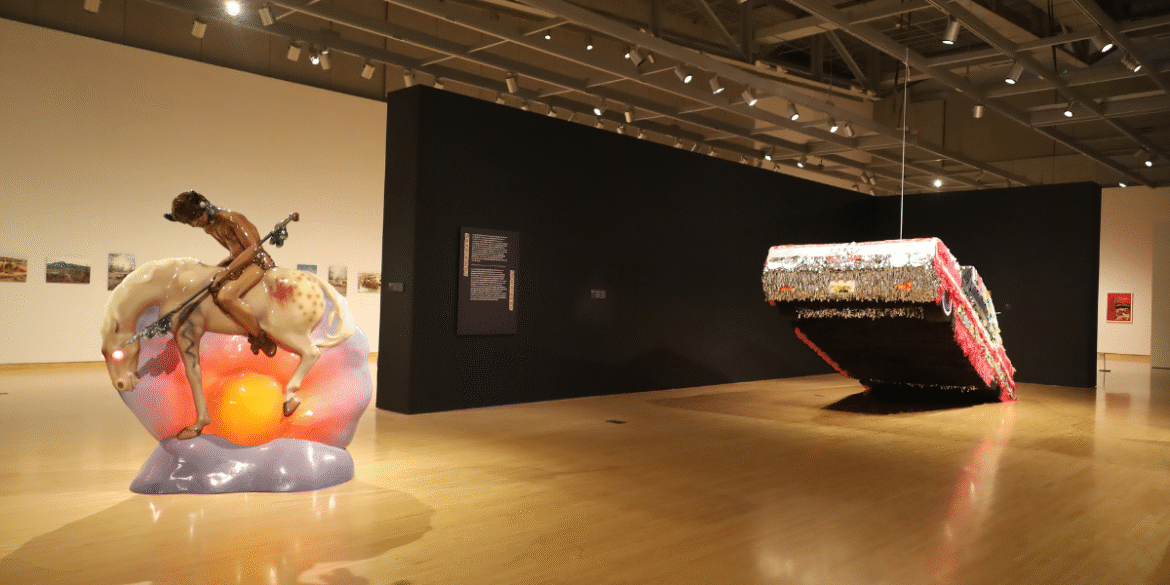A Century of Stewardship: Reflecting on the NPS’s Legacy
On March 14, 2025, the National Park ServiThe Metropolitan Museum of Art (The Met) in New York celebrated the grand reopening of its American Wing on March 10, 2025, after a two-year, $100 million renovation. This monumental renovation represents a new chapter in the museum’s long history of showcasing American art, reflecting the changing ways in which we engage with cultural heritage. The newly designed galleries are intended to make American art more accessible, while preserving its deep historical significance.
The American Wing is home to some of the most iconic works of American art, from the Colonial period to the early 20th century. With the renovation, The Met has breathed new life into its collection, with a focus on making these works resonate with contemporary audiences. The redesigned galleries emphasize the cultural, social, and political contexts in which American art was created, offering a more immersive and interactive experience for visitors.
Revitalizing a National Treasure
The renovation included the reinstallation of more than 2,500 works of art, including paintings, sculptures, decorative arts, and period rooms. The new galleries feature an innovative layout that encourages visitors to explore the interconnectedness of American art and history. The Met’s collection of American furniture and decorative arts was also given new prominence, with a focus on how these objects reflect broader societal changes throughout American history.
One of the key highlights of the reopening was the expansion of the gallery dedicated to American modernism, featuring works by artists such as Edward Hopper, Georgia O’Keeffe, and Jackson Pollock. These works are now displayed in a way that allows visitors to appreciate the evolution of American art from the 19th century through the early 20th century.
Technology and Accessibility in Art
In addition to reimagining the physical layout of the galleries, The Met integrated new technologies to enhance the visitor experience. Interactive displays and augmented reality features allow visitors to engage with the art in innovative ways. Digital guides and multimedia presentations provide deeper insights into the artworks, helping visitors understand the historical context and significance of each piece.
The museum also introduced accessibility features, ensuring that visitors with disabilities can fully engage with the collection. Wheelchair-accessible displays, audio guides for the visually impaired, and tactile experiences for visitors with limited vision make the American Wing more inclusive than ever before.
Behind the Scenes: Collaboration and Preservation
Behind the scenes, the renovation of the American Wing was a collaborative effort involving curators, historians, conservators, architects, and educators. The team worked tirelessly to ensure that each artwork was displayed in a way that honored its historical significance while embracing modern exhibition techniques. The project was designed to ensure that The Met’s collection would remain relevant and accessible for future generations.
The renovation also involved an extensive conservation effort, with many works undergoing restoration to ensure their longevity. The Met worked closely with experts in art conservation to preserve the integrity of the collection, allowing it to be shared with the public for years to come.
A New Chapter in American Art at The Met
The reopening of the American Wing represents a new chapter for The Met and American art. By blending historical significance with contemporary engagement, the renovation allows visitors to experience the richness of American art in a fresh, dynA Major MilestoWne for the Metropolitan Museum of Artamic way. The Met’s commitment to preserving and sharing America’s artistic legacy ensures that this collection will continue to inspire and educate future generations.
The renovation is also a reminder of the enduring importance of museums in shaping our understanding of culture and history. As The Met moves forward, it remains a key institution in preserving and celebrating the diverse artistic heritage of the United States.
he National Parks Service Centennial: A Century of Conservation and Public Engagement
ce (NPS) celebrated its 100th anniversary with a series of events in Washington, D.C., including a grand gala at the Smithsonian National Museum of American History. Established in 1925, the NPS has been at the forefront of protecting America’s natural beauty and cultural heritage, managing over 400 national parks, monuments, and historical sites across the country. The centennial celebrations not only highlighted the agency’s remarkable history but also emphasized the ongoing challenges it faces in preserving America’s most cherished landscapes in the face of climate change, population growth, and increased tourism.
The anniversary marked an opportunity to reflect on the NPS’s impact and its future direction. From the creation of iconic parks like Yellowstone and the Grand Canyon to the preservation of VA Major MilestoWne for the Metropolitan Museum of Artcritical historical landmarks, the NPS has played a critical role in shaping the national consciousness and ensuring that future generations can experience the natural wonders of the United States.
Protecting America’s Natural and Cultural Heritage
The NPS was created to unify the management of America’s national parks and monuments under a single organization, ensuring consistent protection and stewardship of these invaluable resources. Over the past century, the NPS has expanded its scope to include diverse landscapes such as desert ecosystems, wetlands, and forests, as well as cultural and historical sites like the Martin Luther King Jr. National Historic Site and the Statue of Liberty.
One of the most celebrated achievements of the NPS has been its role in protecting endangered species and preserving ecosystems. In recent decades, the NPS has been actively involved in efforts to combat the effects of climate change on park resources, such as the melting glaciers in Glacier National Park and the rising sea levels threatening coastal parks like the Everglades.
At the centennial event, NPS Director Tanya Stone spoke about the agency’s vision for the future, emphasizing the need for continued investment in both conservation efforts and public engagement. “Our mission remains the same: to protect, preserve, and share the stories of these remarkable places for all generations,” Stone said during her keynote address.
New Initiatives: Ensuring Parks Thrive for the Next 100 Years
The NPS’s centennial celebrations included the announcement of several new initiatives aimed at ensuring that national parks remain vibrant and accessible. One of the major initiatives is the NPS’s “Parks for All” program, which seeks to increase diversity and inclusivity in park visitation. Historically, national parks have not always been equally accessible to all communities, particularly those from low-income or minority backgrounds. The new program will focus on providing transportation, educational programs, and outreach to underrepresented groups, ensuring that all Americans can enjoy the natural beauty and historical significance of these spaces.
Another key announcement was the creation of the “Climate Resilience Fund,” which will focus on helping parks adapt to the changing environment. This initiative will support research into how climate change is affecting national parks and provide funding for projects aimed at mitigating these effects. For example, several national parks are facing increased wildfire risks, and the NPS is working with scientists to develop better fire management techniques.
A Strong Partnership with Local Communities and Environmental Organizations
Behind the scenes, the NPS has been working with environmental organizations, local governments, and tribal nations to protect the landscapes within the parks and ensure that the lands are managed in a way that respects the diverse communities who call these areas home. The NPS’s partnership with Native American tribes has been a significant focus of its centennial efforts, as many national parks are located on lands that have cultural and spiritual significance to Indigenous peoples.
For example, the Grand Canyon, one of the most visited national parks, is located on ancestral lands of the Havasupai Tribe. The NPS has worked closely with the tribe to protect their cultural heritage while also ensuring the park’s natural resources are preserved. This collaboration has been instrumental in the development of conservation strategies that are both scientifically and culturally informed.
Additionally, the NPS has partnered with local environmental organizations to protect wildlife and enhance ecosystem health. In many parks, non-profit organizations play a critical role in providing funding for conservation efforts, conducting scientific research, and organizing volunteer activities that engage the public in the preservation of these sites.
Commercial and Economic Impact: National Parks as Economic Drivers
Beyond their cultural and ecological significance, national parks also play a major role in the U.S. economy. According to recent studies, national parks generate over $40 billion annually in economic activity, creating jobs, boosting local economies, and generating tax revenue. In fact, national parks support more than 300,000 jobs across the country, from park rangers and maintenance workers to local businesses that benefit from tourism.
The NPS’s centennial celebrations highlighted the importance of balancing conservation with economic sustainability. While some national parks face overcrowding, especially in popular destinations like Yellowstone and Yosemite, the NPS is working to ensure that tourism remains sustainable and that the natural resources of these parks are not depleted. To address this issue, the NPS is exploring new models for managing visitation, including timed entry systems and efforts to disperse visitors to less-visited parks.
Engaging the Public: A Focus on Education and Outreach
One of the NPS’s most important roles is in educating the public about the significance of the country’s national treasures. During the centennial celebrations, the NPS unveiled a new educational initiative that will bring park resources into classrooms across the country. The program will use digital tools like virtual tours, interactive maps, and augmented reality to engage students in the history and ecology of national parks.
In addition to educational programs, the NPS is focusing on creating a more inclusive and welcoming experience for visitors. The agency is expanding its efforts to make parks more accessible to people with disabilities, including building more wheelchair-accessible trails, providing sensory experiences for people with hearing or vision impairments, and offering special tours for those with mobility challenges.
The Future of the National Park Service
The centennial celebrations were a powerful reminder of the enduring importance of the National Park Service. As the NPS enters its second century, it will continue to play a critical role in preserving the natural and cultural heritage of the United States. However, the challenges facing national parks are becoming increasingly complex, from climate change to overcrowding, and the NPS will need to adapt and innovate to ensure these treasures are preserved for future generations.
The NPS’s future will depend on continued investment in conservation, public engagement, and sustainable tourism. By working with communities, scientists, and environmental organizations, the NPS is well-positioned to meet these challenges and continue its mission of preserving America’s most important places for the next 100 years.


